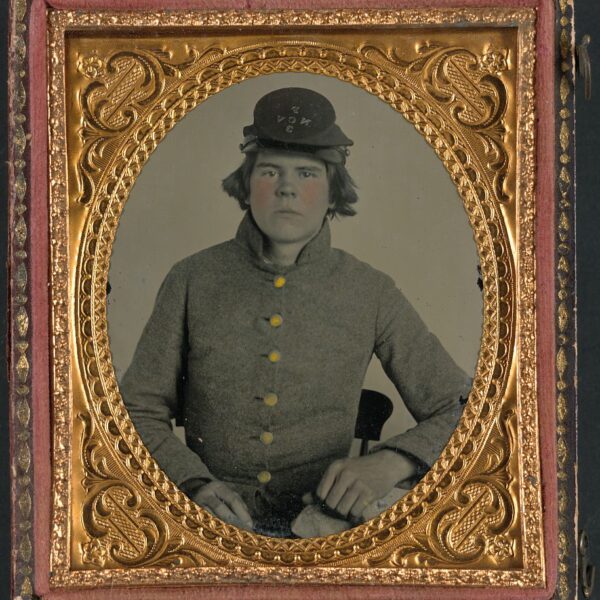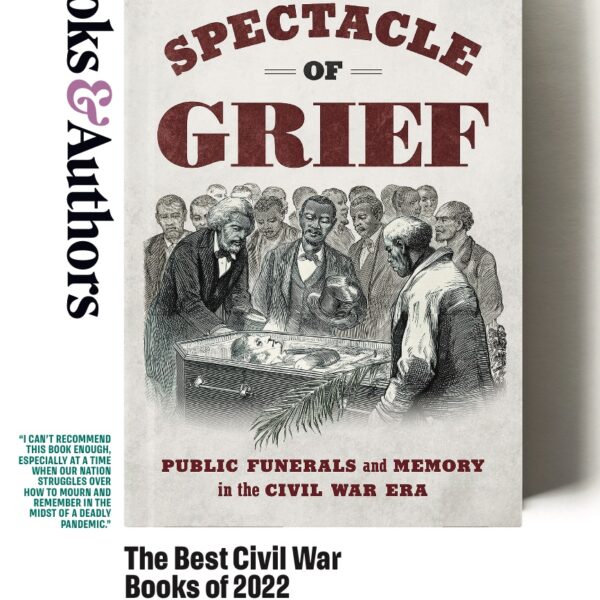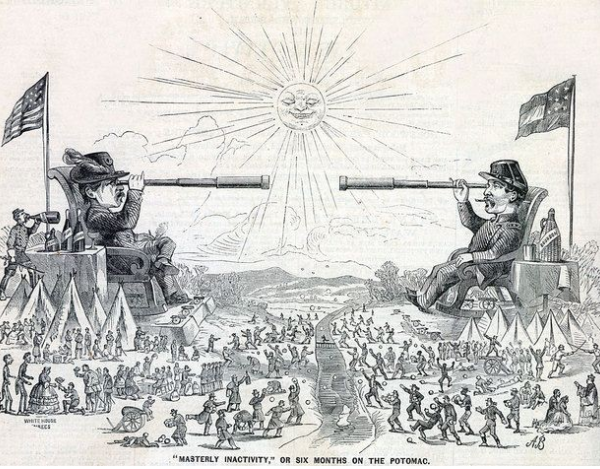![]()
Another year has come and gone and The Civil War Monitor editorial staff is thankful for a very productive 2012. As we begin to make plans for another exciting year, we cannot help but reflect back on 2012 and all the accomplishments of The Monitor’s first full year.
The following is our 2012: Year in Review.
Early in 2012, The Monitor welcomed aboard two new contributing editors. This past year, The Monitor also entered into a partnership with The New York Times’ “Disunion” blog. Fans of “Disunion” gain temporary free access to online editions of The Civil War Monitor.
“The Front Line” blog published 25 analytical posts this year, including:
—- “The Peace Monument At Appomattox, UDC, and Reconstruction” by Caroline Janney,
—- “The Battle For Freedom: Antietam and the Emancipation Proclamation” by Louis P. Masur,
—- “The Consequences of Damning the Torpedoes” by John Grady,
—- and “Did a C.S.S. Alabama Veteran Die in the Titanic Disaster?” by Andy Hall.
“The Bookshelf” published an astounding 69 book reviews! In addition, “The Bookshelf”:
—- circulated movie reviews of Lincoln and Death and the Civil War,
—- published Brian Matthew Jordan’s analysis of the legacy of David Blight’s Race and Reunion,
—- and launched two contests: our “weird” Civil War story contest and our Holiday trivia contest.
In April, The Monitor published a new photo essay, entitled “Life Studies of the Great Army.”
In conjunction with “The Civil War Navy Sesquicentennial” bog, we launched a new series of blog posts entitled “Iron Men Afloat.” Since April, we have worked with The “CWN150” blog to highlight key battles and topics in Civil War naval history:
—- “John Mackie: The Man and the Memory” and “The Battle of Drury’s Bluff”
—- “The Surrender of New Orleans: The Men and The Skirmish”
In August, we launched a new series of online video interviews entitled “Behind the Lines.” Over the last few months, “Behind the Lines” has featured 14 video interviews with notable Civil War scholars such as:
—- Peter Carmichael,
—- Anne Rubin,
—- Elizabeth Leonard,
—- Ric Burns,
—- and Kevin Levin.
In terms of social media, our Facebook following increased by over 500 so we now have 885 faithful fans. Meanwhile, we now have 494 followers on Twitter and have officially surpassed the 2000 tweet mark! Last month, we sent out our first eNewsletter to over 800 subscribers.
And, we published four new issues of the magazine. Below is a summary of Volume 2’s issues.
—-Birth of a Demon – Volume 2, Issue 1.
Birth of a Demon by Thom Bassett
Despite his devastating sweep through Georgia and the Carolinas, William Tecumseh Sherman enjoyed a surprisingly warm postwar relationship with the South. In 1881, Jefferson Davis put an end to that.
Sketches of War: “Life Studies of the Greaty Army” by Edwin Forbes
Debuting a decade after the guns fell silent, Edwin Forbes’ collection of copper etchings captured life in the Union army and marked the pinnacle of the renowned war artist’s career.
Dying in the Desert by Megan Kate Nelson
In July 1861, as more than 600 Union soldiers and civilians fled from Confederate cavalry in the New Mexico Territory, they battled natural—not military—forces in the desolate Southwest.
The Spy and Robert E. Lee: Gettsyburg’s “Lost” Order, June 28, 1863 by Allen C. Guelzo
Contrary to popular belief, the Army of Northern Virginia’s venerable leader did not stumble blindly into what would turn out to be one of the Civil War’s most significant battles.
Musings of a Civil War Bibliophile: The Virtues—and Vices of Early Confederate Biographies by Robert K. Krick
The Books That Built Me by Harold Holzer
—-1862: The War Turns Serious – Volume 2, Issue 2
Lee: Initial Stride to Greatness by Jeffry D. Wert
In his first campaign as Confederate army commander, Robert E. Lee established his reputation as a bold leader—and changed the course of the war in the East.
A Capital in Crisis by Stephen W. Sears
Twelve summer days in 1862 marked the darkest time of the Civil War for Washington, D.C.
Faces of 1862 by Ronald S. Coddington
The war’s second year forever changed the lives of countless Americans—soldiers and civilians—on both sides of the conflict.
Fighting for South Mountain by Brian Matthew Jordan
On the eve of Antietam, Union soldiers won a decisive victory—then fought again to have it remembered.
Northern Divide by Louis P. Masur
The elections of 1862 seemed to offer a severe rebuke to Abraham Lincoln and his preliminary Emancipation Proclamation. The president and his allies, however, read the results much differently.
Essential Reading on…
The War in the West, 1862 by Brooks D. Simpson
The Peninsula Campaign by Glenn David Brasher
The Battle of Fredericksburg by Robert K. Krick
—-The Defiant Ones – Volume 2, Issue 3
“Grant, Your Cause is Ruin” by M. Keith Harris
Outnumbered and outgunned during the siege of Petersburg, the men of Robert E. Lee’s Army of Northern Virginia were nonetheless supremely confident in their ability to deal Ulysses S. Grant’s opposing army a decisive blow—and perhaps win the war as well.
Antietam: Painting the Bloodiest Day
Professional artist turned Union soldier James Hope’s dramatic portraits of the Battle of Antietam serve as a fitting memorial to what remains the bloodiest single-day battle in American history.
The Lost Boys by Kathryn S. Meier
Although they faced serious punishment or being labeled as shirkers (or worse), soldiers on both sides regularly took temporary and unauthorized leaves from their armies—and often for good reason.
Wonder, Delight, Astonishment & The Art of Deception by Edward T. Cotham Jr.
From famous names to moonlighting soldiers, practitioners of magic had a (sleight of) hand in lifting civilian and military spirits during the war—particularly in the South.
Essential Reading on the Maryland Campaign of 1862 by Brian Matthew Jordan
Musings of a Civil War Bibliophile: The Varieties of Primary Civil War Evidence by Robert K. Krick
—-The Gentleman General – Volume 2, Issue 4
The Gentleman General by Glenn W. LaFantasie
How Harvard-educated lawyer turned soldier Manning Ferguson Force helped save the day for the Union army in the battle for Atlanta.
Dixie Boys by Jeff T. Giambrone
Tens of thousands of Mississippians fought for the Confederacy during the Civil War, earning themselves a reputation for unrivaled bravery and tenacity by conflict’s end.
A Succession of Horrors by Brian Dirck
A step-by-step account of the horrific explosion that rocked the U.S. Arsenal in Washington, D.C., on June 17, 1864.
The Origins of Freedom by Glenn David Brasher
While many give Antietam the credit, it was the Union’s failed campaign on the Virginia Peninsula during the spring and summer of 1862 that helped convince many in the North—chief among them Abraham Lincoln—that slavery must be abolished.
The Best Civil War Books of 2012
Musings of a Civil War Bibliophile: Confederate Diaries, Priceless but Terse by Robert K. Krick
We certainly had a great year full of accomplishments and we thank you all for being a part of it!
Happy New Year and Many Thanks!
Laura June Davis, Contributing Editor




